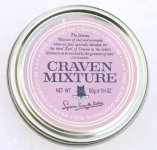It's often been stated that we are in a golden age, in terms of the number of tobacco brands and blends available. Yet, when I look at the backs of my tins, I find the same few parent companies over and over. It seems that there are only a few entities that actually produce the bulk of our pipe tobacco. As a relative newcomer, I ask: Has it always been this way? If it has not always been this way, what might it mean for the future?
Too Many Blends, But Too Few Producers?
- Thread starter pauls456
- Start date
You are using an out of date browser. It may not display this or other websites correctly.
You should upgrade or use an alternative browser.
You should upgrade or use an alternative browser.
SmokingPipes.com Updates
Watch for Updates Twice a Week
- Status
- Not open for further replies.
Don't listen to your average young folks. Monopoly is the golden rule of capitalism, and as you found out it's working beautifully with pipe tobacco blends.
There's not sufficient volume to justify dozens of manufacturers. What are there, 7, 8, maybe 10? That's plenty.
Ok, but I imagine a time when there were lots of small producers, each making its own distinctive products. Some possible effect of monopoly might include higher quality overall, but more redundancy among the numerous blends that these factories produce.
Of course, we're lucky to have what we have..
Of course, we're lucky to have what we have..
Pretty much for at least the last few decades.Has it always been this way?
The problem for small tobacco manufacturers nowadays is costs. From subsidies getting cut for tobacco farmers, FDA costs now, and distribution in an online market, in a teeny tiny pipesmoking market, a small pipe tobacco company can’t compete.
Pipe tobacco production has fallen exponentially over the past 30 years. Yes, there used to be many more pipe tobacco manufacturers, as well as tobacco growers and producers, but the shrinking sales volumes and increasing government regulation has made that economically unsustainable. Thus, the incredible consolidation that has left us with just a handful of pipe tobacco manufacturers worldwide.
I can't say that this has been good for the customer. While product quality has, in general, remained high, the diversity of offerings has shrunk precipitously. Processes and ingredients have been made uniform, eliminating the unique character that each blending house once had. Manufacturers that could justify small runs of unique products have been swallowed up by large corporations with much higher production run minimums. Growers that might harvest just small amounts of unique tobacco leaf for sale to smaller companies, now find themselves growinga more uniform leaf under contract to big buyers. And, of course, once production is concentrated in the hands of a few producers, competition is stifled and prices rise.
I can't say that this has been good for the customer. While product quality has, in general, remained high, the diversity of offerings has shrunk precipitously. Processes and ingredients have been made uniform, eliminating the unique character that each blending house once had. Manufacturers that could justify small runs of unique products have been swallowed up by large corporations with much higher production run minimums. Growers that might harvest just small amounts of unique tobacco leaf for sale to smaller companies, now find themselves growinga more uniform leaf under contract to big buyers. And, of course, once production is concentrated in the hands of a few producers, competition is stifled and prices rise.
It's tough to stay in the pipe tobacco arena without a stable of good to great selling tobaccos. That kind of pushes us towards the big boys.
This. In one of their corporate promotional pieces on the web, STG stated that two thirds of all leaf used in pipe tobacoo worldwide came from three leaf processors. These companies contract with growers. Their principal business is supplying tobacco for cigarette companies at the lowest possible cost. Since the raw material used is stalk harvested, homogenized, tobacco , it really doesn’t matter that there are only a few manufacturers. There is a whole industry that provides flavorings for tobacco, and tobacco is absorptive, so the companies left can come up with all sorts of “new” creations.Growers that might harvest just small amounts of unique tobacco leaf for sale to smaller companies, now find themselves growinga more uniform leaf under contract to big buyers.
It's like fruit industry. We get mediocre run of mill fruits and are somewhat happy. Banana for example, there are ton of banana varieties. But 99% of people only know the seedless yellow ones we see at the market. Or figs. If you are lucky to see fresh fig at your grocery, they are more than likely one of few commonly available. At least with figs, European understand and enjoy different cultivars. Middle East and Mediterranean region is fig heaven.
I forgot what I was talking about.
I forgot what I was talking about.
Monopoly may be the goal; but competition, which is the real product of capitalism, always wins and produces more products at lower prices. Unless the government gets involved.Don't listen to your average young folks. Monopoly is the golden rule of capitalism, and as you found out it's working beautifully with pipe tobacco blends.
I like novelty, but after trying about 125 blends I’m settling on a few. I’m not sure that it would provide me any value to have more manufacturers, as it would make for more experimentation just to settle to a few.
A lot of things have changed, and while there do seem to be fewer players the actual selection - both in blends and manufacturers available for purchase - doesn't seem to have gone down that much in the last 30 years. The internet has vastly increased the tobaccos I can actually purchase, the catalog of blenders like Peretti are just a click away (much to the detriment of my wallet). We've lost Elephant & Castle and Harrods, and lost and regained John Cotton and Balkan Sobranie, but afaik E&C were made by McConnell and Harrods was made by Fox, now McConnell - which was itself a conglomerate of brands - has been absorbed into a larger conglomerate but I can now purchase all of the Rattray blends and all of the McConnell blends instead of being limited to what I can get at the local shop (may it rest in peace). Things have changed but I wouldn't say it's better or worse, just different.
Or maybe it's just that I've standardized on McConnell, Rattray, and Peretti.
Or maybe it's just that I've standardized on McConnell, Rattray, and Peretti.
If there was a consumer demand for more blenders there would be more blenders. Thats the beauty of capitalism when its functioning properly. Of course in this regulatory environment it can't function properly.
Dan,Pipe tobacco production has fallen exponentially over the past 30 years. Yes, there used to be many more pipe tobacco manufacturers, as well as tobacco growers and producers, but the shrinking sales volumes and increasing government regulation has made that economically unsustainable. Thus, the incredible consolidation that has left us with just a handful of pipe tobacco manufacturers worldwide.
I can't say that this has been good for the customer. While product quality has, in general, remained high, the diversity of offerings has shrunk precipitously. Processes and ingredients have been made uniform, eliminating the unique character that each blending house once had. Manufacturers that could justify small runs of unique products have been swallowed up by large corporations with much higher production run minimums. Growers that might harvest just small amounts of unique tobacco leaf for sale to smaller companies, now find themselves growinga more uniform leaf under contract to big buyers. And, of course, once production is concentrated in the hands of a few producers, competition is stifled and prices rise.
Thanks for the intelligent straightforward explanation. Much appreciated.
At the same time, there's things like Russ Ouellette's blends exploring periques from different places. If enough people are interested in "terroir-driven" tobacco, this is bound to pick up steam. But the main problem, as has been pointed out, is that we are a tiny and regulation-smothered market.
I'm having a hard time imagining more variety than what is currently available. Or whether that would be useful. My closet is already a riot of colorful unopened tins of this and that, in a quantity and variety that seems a bit excessive for anyone but a tobacco loon. What if I kick, one day, without trying them all? That would piss me off no end. I do feel McClelland's absence though. And the old Balkan Sobrainie White. And Black. And Virginia #10. And the glorious Craven Mixture. Sigh...




While there are still a lot of SKU's out there, there is a lot of duplication. The same blend being sold under multiple labels. From my brief time "in the business" I know of many such examples. The other situation is that although there may be a multitude of blends from any given manufacturer, the base ingredients, and the processes used to produce these blends, remain the same. The key to profitability is scale and uniform manufacturing processes. Which, in turn, leads to uniform products.
The label is more unique than than what's inside the tin.
The label is more unique than than what's inside the tin.
I feel fortunate to have a tobacconist 8 minutes away who produces blends .
There is a bit of a difference in that a level of individuality in makers style has disappeared. Most of the labels you see are the product of one of several conglomerates who contract the same suppliers for their components. McConnell may have made blends for Rattray's, but they could buy what Rattray's bought. Now it all part of K&K and they and the many other blends that K&K produce are made from the same stuff.A lot of things have changed, and while there do seem to be fewer players the actual selection - both in blends and manufacturers available for purchase - doesn't seem to have gone down that much in the last 30 years. The internet has vastly increased the tobaccos I can actually purchase, the catalog of blenders like Peretti are just a click away (much to the detriment of my wallet). We've lost Elephant & Castle and Harrods, and lost and regained John Cotton and Balkan Sobranie, but afaik E&C were made by McConnell and Harrods was made by Fox, now McConnell - which was itself a conglomerate of brands - has been absorbed into a larger conglomerate but I can now purchase all of the Rattray blends and all of the McConnell blends instead of being limited to what I can get at the local shop (may it rest in peace). Things have changed but I wouldn't say it's better or worse, just different.
Or maybe it's just that I've standardized on McConnell, Rattray, and Peretti.
While there's nothing new in this, the extent of consolidation is much higher in today's world. And the number of blends is a bit illusory since so many blends are tinned under multiple labels - 1Q alone having been tinned in about 26 different labelings. Peretti only made some of its blends. Sutliff makes flakes for them and McClelland made some product for them as well.
- Status
- Not open for further replies.






